Posted by
Shay Harel
2019 continues to fascinate me. There has yet to be some sort of massive blow out Google update (calm before the storm?). There has yet to be some sort of massive earth-shaking announcement, the kind that prompts SEOs to create a portmanteau that ends in ”
Here is the March 2019 edition of the SERP News!

New and Dynamic Elements Added to Local SERP Features
I don’t think I’m saying anything too novel by stating that ‘local’ is becoming more and more important to Google (though, the reason why I think so
Let’s have at it, shall we?
Save Your Spot in Line with the Local Panel
Probably the most novel local SERP feature addition of the year thus far, Google has added a “Get In Line” button to the Local Panel. Appearing, at this point, for select restaurants, the new Get In Line button does what it says it does, it gets you a spot in line. The idea is to give restaurant goers an easy way to put themselves into the queue when an eatery presents them with wait time in order to grab a table.
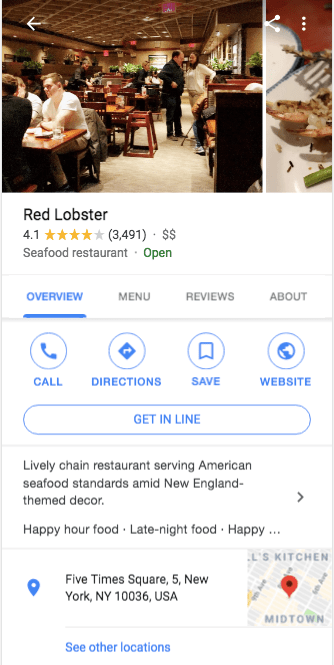
Hold your place in line at a restaurant via the Local Panel (Image Source: SERoundtable.com)
Other than being a great feature that helps users avoid sitting around on that leather couch that occupies a restaurant’s entrance, the Get In Line button is a big jump forward in terms of user dependency on Google properties. Simply, it’s a unique and highly helpful feature that exists solely within Google’s ecosystem. More, it’s yet another element that presents seamless integration into the voice search arena. The new element seems to be the natural evolution of the Reserve with Google program and should only bolster its adoption.
Reserve with Google Expands and Gets a New Local Pack Filter
Speaking of Reserve with Google, the program expanded this past month. As caught by Sergey
Along with more opportunities to engage with Reserve with Google, users can also make use of a reservation filter within the Local Pack. The filter lets you indicate the size of your party along with the day and time you wish to reserve.
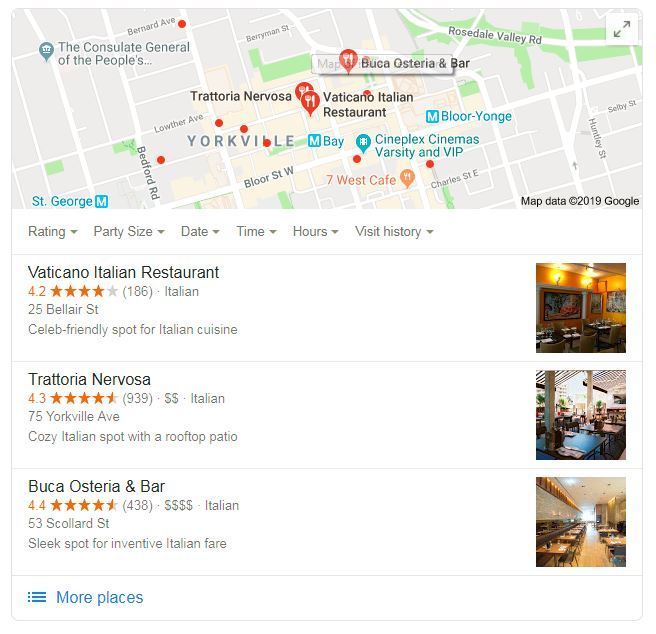
Comprehensive reservation filters within the Local Pack (Image Source: Alakov.com)
Even More Tests & Changes to the Hotel Local Listings
What a surprise, Google ran more tests to hotel listings (I’m, of course, being sarcastic). First and foremost there was a limited test that brought hotel price insights to desktop. Mobile hotel Price Insights were released back in July 2018. Their insertion into the Hotel Local Panel essentially brought competition into what was otherwise sacred brand space as Google used the insights to showcase hotels other than the one represented in the Local Panel itself.
Having the Price Insights on
Next up was a test that had Hotel Local Packs appearing with four listings on mobile. Of course, the Hotel Local Pack on desktop saw a visually stunning overhaul in November 2018. Part of that saw four hotel listings within the desktop Hotel Local Pack (as opposed to three). With the test, mobile appears to be perhaps
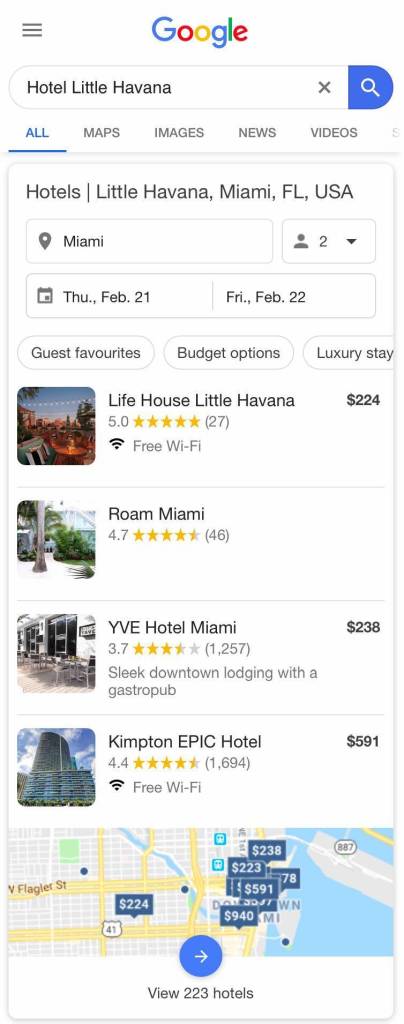
A mobile hotel Local Pack showing with four listings (Image Source: Alakov.com)
Last up, and not a test but rather a permanent change, hotel brands can now add check-in and check-out times to their local listings. I’m a bit surprised that we’re only now getting this information within Google’s local features as the information seems highly pertinent to users.
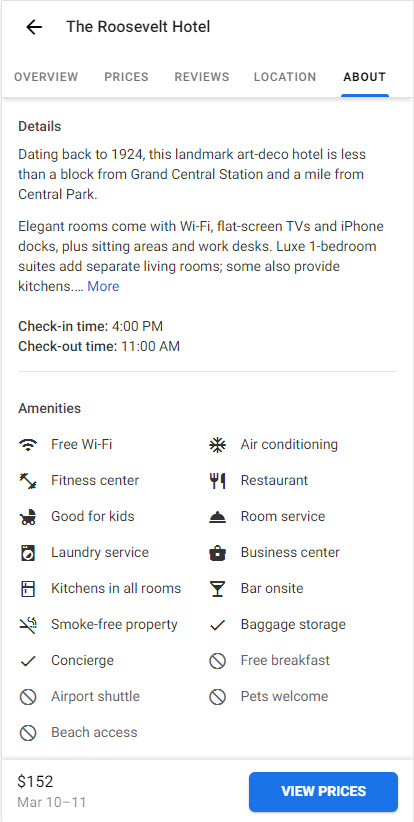
Check-in and Check-out hours for a hotel as they appear within the Local Panel
Google Posts Clones Itself Throughout Local SERP Properties
A really interesting test found Google Posts copying themselves across all of an entity’s local SERP feature properties. That is, a single post was found showing within the Local Knowledge Panel, Local Finder, and even the Local Pack. Google has experimented with integrating Posts into the Local Pack in the past. This makes a lot of sense as it brings the feature to more users, users who did not specifically execute a brand query.
Google Walks Into Some Featured Snippet Controversy
Late in February, Cyrus Shepard spotted an interesting Featured Snippet format on mobile. Google placed the snippet under the title Found on the Web and presented a series of answers to the query without any URLs being shown (initially). In other words, you had what would normally be a list format within the Featured Snippet showing up as separate expandable tabs, each tab reflecting the “answer” along with the first few words in what would be a “traditional” Featured Snippet.
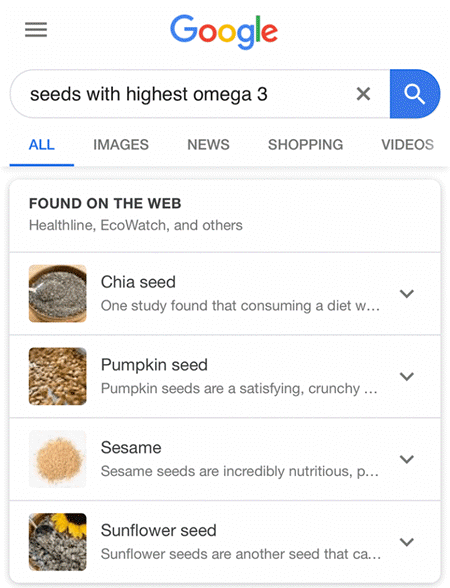
A new Featured Snippet format shows a list answer in as expandable tabs
Upon expanding any given tab Google presented a carousel of various Featured Snippets from a variety of sources (here the URL does appear). In this way, the tested format mimics Bing’s Multi-Perspective Answers.
Now for the controversy. Here’s what the Featured Snippet format for the query normally looks like:
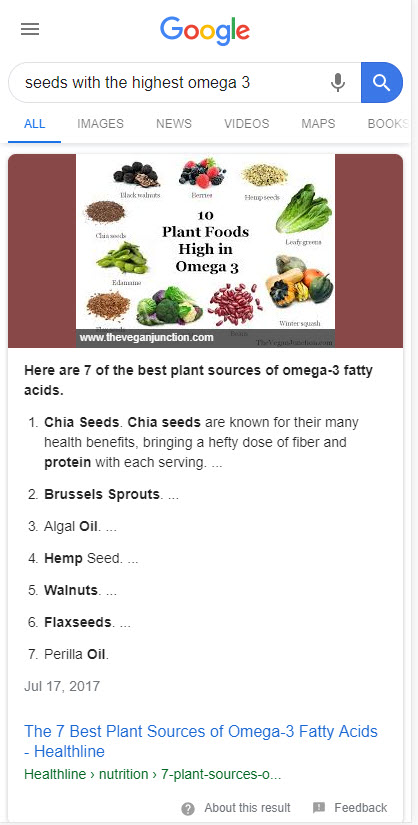
In the above instance, the users
Now, the way Google goes about showcasing their SERP features is a sore point for many within the SEO industry
I know many in the industry are very unhappy with the format seen in this test. I am not trying to delegitimize that and Google’s overall use of its features should be questioned when legitimate. All I am saying is that I personally don’t see how this format is any more “problematic” than what we’ve seen on the SERP previously.
Google’s February 2019 Algorithm Activity
While there
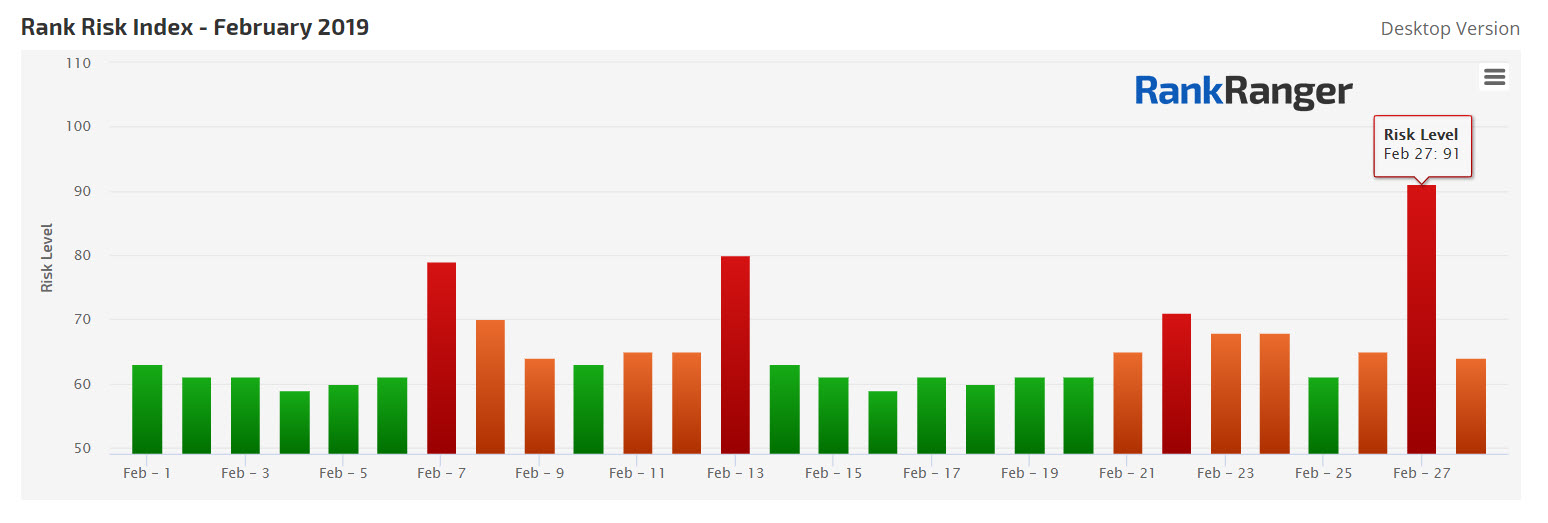
The Rank Risk Index showing two sets of increased rank fluctuations during February 2019
Just a week later we caught
Additional Changes to the Google SERP Made in February 2019
Some pretty atypical changes popped up on the SERP during February. By atypical I mean that the changes reflected more than just an image thumbnail being added to some SERP feature and the like. I could go on trying to explain what I mean or I could just show you
Answers to Search Queries Bolded in Organic Site Descriptions
As 2019 rolled-in I spotted mobile Knowledge Panels that were using bolded text in much the same way a Featured Snippet would. This past month, Australian SEO Brodie Clark reported that Google has been using bolded text in a similar manner within organic descriptions on the SERP. Google has, of course, bolded text within the description since time immemorial, but only for the keyword itself. In the case Brodie found, Google was bolding a snippet of content that reflected an answer to the query – as it does within Featured Snippets.
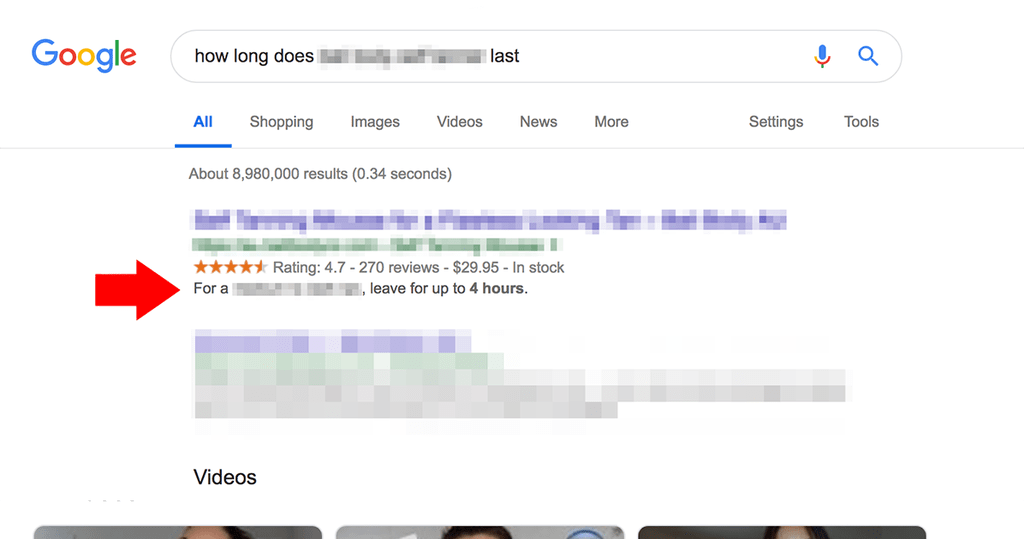
Bolded text within the description reflects the answer to the query (Image Source: BrodieClark.com)
Google Offers Space Eating Video Grids on Mobile
Google is now often using a grid format in place of its traditional carousel of videos on mobile. In most cases, four videos appear within the grid (two rows with each row containing two videos). However, numerous cases of the new format produced grids containing up to 8 videos.
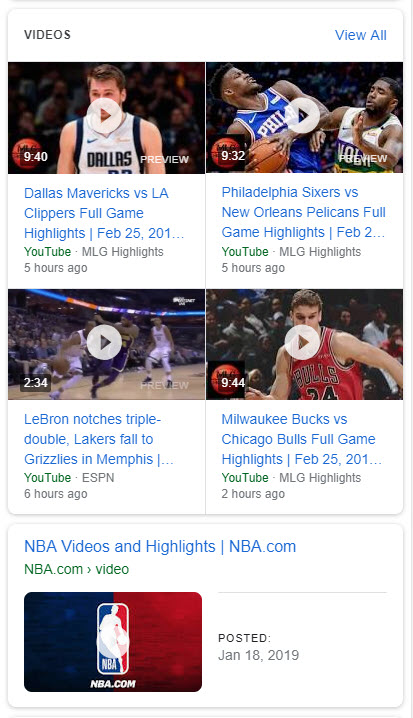
A grid format replacing the traditional video carousel on some mobile SERPs
In either case, whether Google shows four or eights videos within the grid, the new format gobbles up more limited mobile SERP space than the carousel. Beyond pushing more organic results further below the fold, the grid format is intrinsically far more visible than the carousel we have become accustomed to seeing on mobile.
More Image Search Options
Though I don’t think these are the big changes to image search that Google has been hinting at, I do think these three changes to how users interact with images are quite helpful.
In early February, Google tested showing the Image Box underneath its bubble filter (much the way images are shown within image search per se). Personally, I like the notion of throwing the filter onto the SERP itself. Why not offer users a way to refine their image desires without having to move to a full-on image search?
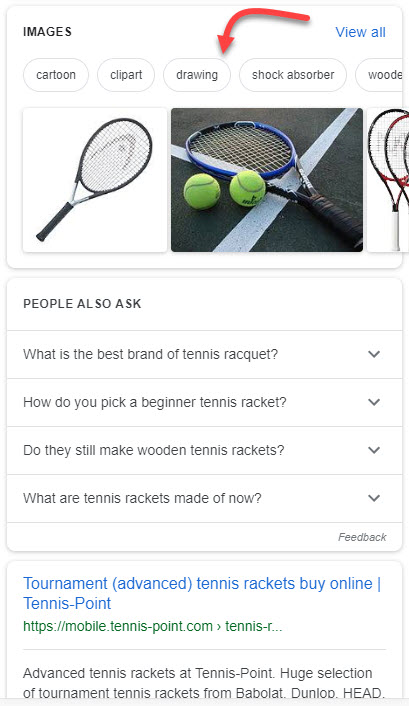
Bubble filters appearing above an Image Box on the mobile SERP
Then, on February 13th, it was discovered that Google was telling users which images within image search they recently viewed. Again, I like this feature. I think it’s particularly helpful when undertaking research or creating content and so forth.
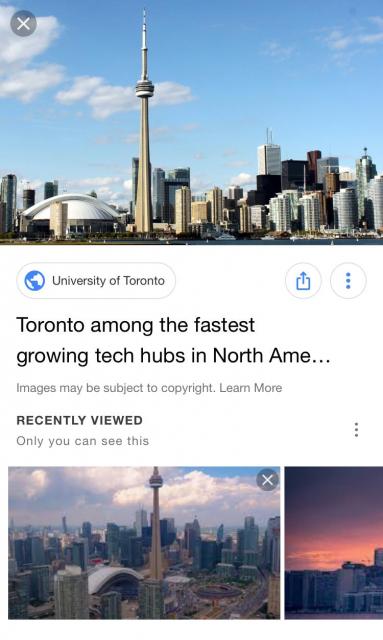
A test informs image search users of the images they recently viewed (Image Source: SERoundtable)
Last but not least, towards the end of February Google started running a “swipe to next” notification on mobile within Image Search. When you enlarge a specific image Google is now running a notification that lasts for a few seconds prompting you to swipe to see the next image in the series.
You can see the test here:
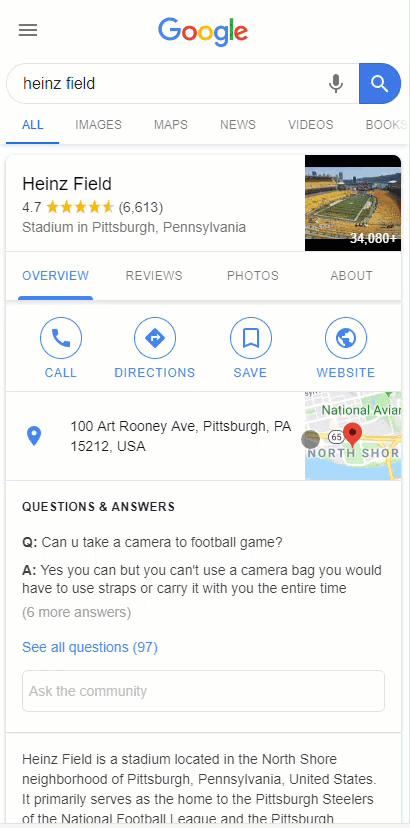
Google’s Event Supercenter Hits the Desktop SERP
The summer of 2018 saw the mobile SERP get a major overhaul of its “events.” Since that time users clicking on event markup were sent to what I’ll call the equivalent of a Local Panel. Here, users could save the event, find other dates when the event takes place, and even purchase tickets. In what was a very limited test this event supercenter appeared on desktop. Like the desktop price insights mentioned earlier, why wouldn’t this eventually become a permanent fixture on
Google Flights Hit by Big Bug
Word came out on February 15th that Google Flights had undergone a disappearing act. Our SERP feature tracker confirmed the drop-off. While the feature does not show on an excessive number of SERPs, our SERP feature tracker caught it appearing on just .28% of all SERPs, down from its usual .6% showing (which reflects a 50% loss – US desktop).

Google flights underwent a drastic one-day loss that appears to have been a bug
Keeping a Healthy SERP Perspective

I could end off this edition of the SERP news rehashing some of the finer points and changes noted above. Instead, I’m going to get a bit controversial myself… well not really, but it sounded good. What I want to say is that the SERP is going to change dramatically in the relatively near future (my personal opinion, of course). As that happens there are going to be real issues, serious issues that sites will have to deal with. I hate to be so cliche but the timeless adage that it’s important to pick your battles rings true.
There are going to
And lucky for you, you have this monthly SERP news digest to keep you up to **** on these changes! (How’s that for a seamless little plug?!)
Thanks for reading!

